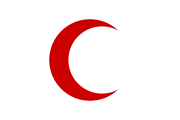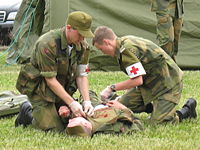
Protocol III
Encyclopedia

Protocol (diplomacy)
In international politics, protocol is the etiquette of diplomacy and affairs of state.A protocol is a rule which guides how an activity should be performed, especially in the field of diplomacy. In diplomatic services and governmental fields of endeavor protocols are often unwritten guidelines...
to the Geneva Conventions
Geneva Conventions
The Geneva Conventions comprise four treaties, and three additional protocols, that establish the standards of international law for the humanitarian treatment of the victims of war...
relating to the Adoption of an Additional Distinctive Emblem. This protective sign
Protective sign
Protective signs are symbols to be used during an armed conflict to mark persons and objects under the protection of various treaties of International Humanitarian Law . While their essential meaning can be summarized as "Don't shoot!" or "Don't attack!", the exact conditions implied vary depending...
(shown) may be displayed by medical and religious personnel at times of war, instead of the traditional Red Cross or Red Crescent symbols. People displaying any of these protective emblems are performing a humanitarian service and must be protected by all parties to the conflict.
History
By the middle of the 19th century, modern weapons had become increasingly more violent. It was not uncommon for a combat medicCombat medic
Combat medics are trained military personnel who are responsible for providing first aid and frontline trauma care on the battlefield. They are also responsible for providing continuing medical care in the absence of a readily available physician, including care for disease and battle injury...
on the field of battle to be fired upon
Friendly fire
Friendly fire is inadvertent firing towards one's own or otherwise friendly forces while attempting to engage enemy forces, particularly where this results in injury or death. A death resulting from a negligent discharge is not considered friendly fire...
, and to die, while collecting and caring for the wounded. There was a growing recognition of the need to distinguish medical personnel from enemy combatants, to make it easier for military commanders to avoid and protect them. Allowing each country to develop its own emblem would have led to confusion. What was needed to save lives was a single neutral emblem that all countries recognized and used equally.


First Geneva Convention
The First Geneva Convention, for the Amelioration of the Condition of the Wounded in Armies in the Field, is one of four treaties of the Geneva Conventions. It defines "the basis on which rest the rules of international law for the protection of the victims of armed conflicts." It was first adopted...
of 1864 establishes that a distinctive emblem should be worn by medical personnel on the field of battle as an indication of their humanitarian mission and their neutral status. At that time, the chosen symbol was a red cross on a white background. Muslim nations have objected to this symbol, possibly due to its resemblance to the Christian cross
Christian cross
The Christian cross, seen as a representation of the instrument of the crucifixion of Jesus Christ, is the best-known religious symbol of Christianity...
. As early as 1876, the Ottoman Empire
Ottoman Empire
The Ottoman EmpireIt was usually referred to as the "Ottoman Empire", the "Turkish Empire", the "Ottoman Caliphate" or more commonly "Turkey" by its contemporaries...
introduced the Red Crescent as an alternative, less Christian emblem. Additional emblems have been proposed, including the red lion and sun of Persia
Red Lion and Sun Society
The Red Lion and Sun Society of Iran was established in 1922 and admitted to the International Red Cross and Red Crescent Movement in 1923...
, the double emblem (both the red cross and red crescent together) by the Red Cross Society of Eritrea
Eritrea
Eritrea , officially the State of Eritrea, is a country in the Horn of Africa. Eritrea derives it's name from the Greek word Erethria, meaning 'red land'. The capital is Asmara. It is bordered by Sudan in the west, Ethiopia in the south, and Djibouti in the southeast...
, and the red shield of David by Magen David Adom
Magen David Adom
The Magen David Adom is Israel's national emergency medical, disaster, ambulance and blood bank service. The name means "Red Star of David"...
of Israel.
Over time the adoption of a single, universal emblem has been met with two recurrent difficulties:
- They may be perceived as having religious, cultural or political connotations. This perception conflicts with neutral, humanitarian status of medical personnel in armed conflicts.
- These emblems are tied to membership in the National SocietiesInternational Federation of Red Cross and Red Crescent SocietiesThe International Federation of Red Cross and Red Crescent Societies is a humanitarian institution that is part of the International Red Cross and Red Crescent Movement along with the ICRC and 186 distinct National Societies...
. Members are required to use the red cross or red crescent emblem. Since Magen David AdomMagen David AdomThe Magen David Adom is Israel's national emergency medical, disaster, ambulance and blood bank service. The name means "Red Star of David"...
was unwilling to give up their red shield of David, they were not granted membership. Without membership, they were not eligible for certain protections under the Geneva ConventionsGeneva ConventionsThe Geneva Conventions comprise four treaties, and three additional protocols, that establish the standards of international law for the humanitarian treatment of the victims of war...
.
In 2005, an international delegation finally achieved a comprehensive solution to these difficulties with the adoption of Protocol III. Magen David Adom is granted protections under the Geneva Conventions as long as they display the Red Crystal in the context of international conflict. As of 2011, Protocol III has been ratified or acceded to by 54 countries and signed by a further 36. The treaty came into force on 14 January 2007.
Governing rules

Protocol (diplomacy)
In international politics, protocol is the etiquette of diplomacy and affairs of state.A protocol is a rule which guides how an activity should be performed, especially in the field of diplomacy. In diplomatic services and governmental fields of endeavor protocols are often unwritten guidelines...
recognizes an additional distinctive emblem, the Red Crystal, that may be used in addition to, and for the same purposes as, the Red Cross and Red Crescent symbols. All three emblems are appointed the same legal status.
There are two distinct uses that are recognized for all three emblems:
- Protective use. Medical and religious personnel may mark themselves, their vehicles, ships and buildings as a sign of their humanitarian mission and protected status under the Geneva ConventionsGeneva ConventionsThe Geneva Conventions comprise four treaties, and three additional protocols, that establish the standards of international law for the humanitarian treatment of the victims of war...
, particularly the First Geneva ConventionFirst Geneva ConventionThe First Geneva Convention, for the Amelioration of the Condition of the Wounded in Armies in the Field, is one of four treaties of the Geneva Conventions. It defines "the basis on which rest the rules of international law for the protection of the victims of armed conflicts." It was first adopted...
. The protections of the Geneva Convention do not depend on the wearing of the emblem. The emblems are merely a visible sign of the protected status of individuals. Members of the armed forces may use these markings at all times. Civilian institutions such as hospitals may use these markings temporarily, within the context of an armed conflict.
- Indicative use. Members of the movementInternational Red Cross and Red Crescent MovementThe International Red Cross and Red Crescent Movement is an international humanitarian movement with approximately 97 million volunteers, members and staff worldwide which was founded to protect human life and health, to ensure respect for all human beings, and to prevent and alleviate human...
may wear the emblems in both times of conflict and times of peace as an indication of their membership.
Misuse of these emblems is prohibited by international law
International law
Public international law concerns the structure and conduct of sovereign states; analogous entities, such as the Holy See; and intergovernmental organizations. To a lesser degree, international law also may affect multinational corporations and individuals, an impact increasingly evolving beyond...
. Misuse may diminish their protective value and undermine the effectiveness of humanitarian workers. Use of one of the emblems in order to protect combatants and military equipment with the intent of misleading an adversary, perfidy
Perfidy
In the context of war, perfidy is a form of deception, in which one side promises to act in good faith with the intention of breaking that promise once the enemy has exposed himself .The practice is specifically prohibited under the 1977 Protocol I Additional to the...
, is considered a war crime
War crime
War crimes are serious violations of the laws applicable in armed conflict giving rise to individual criminal responsibility...
.
See also
- List of parties to the Geneva Conventions: includes a list of states that signed and a list of states that have ratified Protocol III

